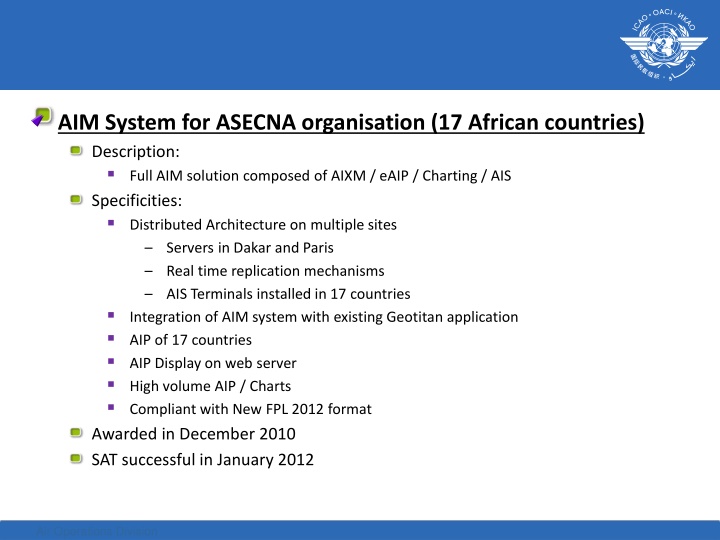
Advanced Aeronautical Information Management System for ASECNA Organization
Explore the comprehensive AIM system implemented for ASECNA across 17 African countries, featuring distributed architecture, real-time replication mechanisms, and integration with existing applications. Discover the benefits and challenges of transitioning from AIS to AIM, including the development of a centralized aeronautical database and adoption of AIXM standards.
Download Presentation

Please find below an Image/Link to download the presentation.
The content on the website is provided AS IS for your information and personal use only. It may not be sold, licensed, or shared on other websites without obtaining consent from the author. If you encounter any issues during the download, it is possible that the publisher has removed the file from their server.
You are allowed to download the files provided on this website for personal or commercial use, subject to the condition that they are used lawfully. All files are the property of their respective owners.
The content on the website is provided AS IS for your information and personal use only. It may not be sold, licensed, or shared on other websites without obtaining consent from the author.
E N D
Presentation Transcript
AIM System for ASECNA organisation (17 African countries) Description: Full AIM solution composed of AIXM / eAIP / Charting / AIS Specificities: Distributed Architecture on multiple sites Servers in Dakar and Paris Real time replication mechanisms AIS Terminals installed in 17 countries Integration of AIM system with existing Geotitan application AIP of 17 countries AIP Display on web server High volume AIP / Charts Compliant with New FPL 2012 format Awarded in December 2010 SAT successful in January 2012 Air Operations Division
Benefits of such a system for the AFI region Strong experience of large system Possibility of extension or duplication of the system Air Operations Division
Challenges of ASECNA Transition from AIS to AIM The main challenges of the ASECNA transition are: Implementation of a centralized aeronautical database able to ensure the reliability, the integrity and the availability of timely data; Compatibility and easy exchange of data with other databases ; Coherent automation of the main functions for the production of the different elements of the integrated aeronautical information package ; and Facilitation of the interoperability with meteorological products and the flight plan management system. Project title (Insert, Header & Footer) 3
Challenges of ASECNA Transition from AIS to AIM (2) Conception and realization of the database: The database will be conceived in accordance with the aeronautical information conceptual model (AICM) / Aeronautical information exchange model(AIXM) endorsed by ICAO. The installation program is subdivided into two phases: Project title (Insert, Header & Footer) 4
Challenges of ASECNA Transition from AIS to AIM (3) Stage 1: Installation of the static database and automation of the cartographic (2010-2011). AIP functions and The equipment system of management of an automated database AIXM and the automation of all ASECNA AIS/NOF/ARO/ briefing offices has been acquired. Project title (Insert, Header & Footer) 5
Challenges of ASECNA Transition from AIS to AIM (4) Stage 2: Installation of the dynamic database and automation of the NOTAM functions, PIB (Pre-Flight information bulletins) and Flight plans (2011-2013). Exchange with other databases: ASECNA database will be in compliance with International Standards permitting exchanges with other operators. For this purpose, agreements of exchange could be established with EUROCONTROL/EAD and the AFI-CAD Group Staff Training Training modules on the management of the aeronautical data has been implemented at EAMAC (African Civil aviation and meteorological Training center) to enable AIM personnel with training tools to update them with the new challenges of AIM. AIM Quality Management System (QMS AIM) With regards to implementation of an AIS Quality Management System as per Annex 15 chapter 3.2.1 and ISO Certification as recommended in Annex 15, chapter.3 paragraph 3.2.2., ASECNA has firmly put in place different QMS tools for AIM services. Project title (Insert, Header & Footer) 6
Challenges of ASECNA Transition from AIS to AIM (5) Implementation of the electronic terrain and obstacle data (eTOD) Studies are in progress on the realization of works concerning different zones specified by ICAO as per amendments 36 and 37 to Annex 15. WGS-84 points maintenance and extension: WGS-84 network maintenance and extension works are on-going as foreseen in the ASECNA consolidated Plan of Services and Equipment (PSE). Project title (Insert, Header & Footer) 7
CONCLUSION ASECNA roadmap for the transition from AIS to AIM: The different programs foreseen in the ASECNA transition plan are consistent with the ICAO Roadmap for AIS/AIM Transition as per attachment. ASECNA ROADMAP FOR AIS/AIM TRANSITION ICAO Stages Objectives ASECNA Plan Stage I II III 2010-2011 2010-2013 2014-2018 Quality requirement X X AIRAC conformity X I Implementation of the WGS 84 X X Consolidation eTOD X SARPs for the existing products X X II Implementation of databases X X Digitalisation New products (eAIP,GIS) X X New services X III Future ATM new data Information Management X Project title (Insert, Header & Footer) 8
